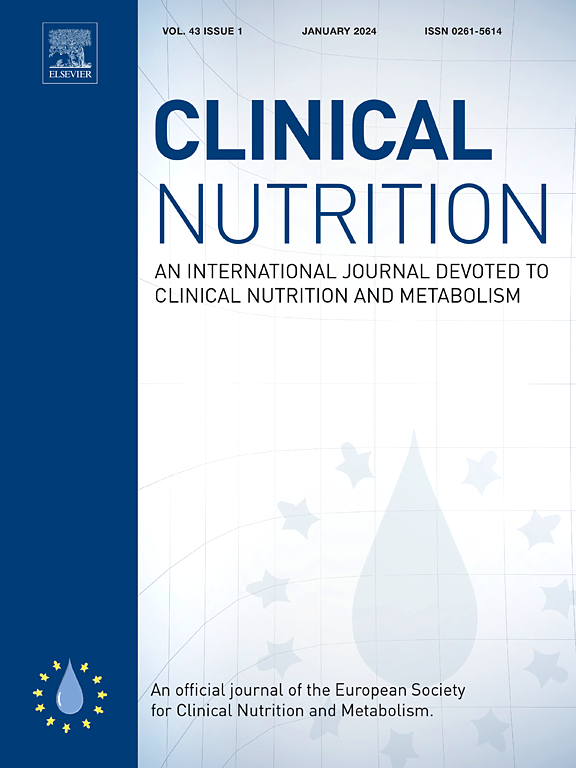New insights on the use of mini nutritional assessment: Impact of alternative calf circumference cutoffs
IF 6.6
2区 医学
Q1 NUTRITION & DIETETICS
引用次数: 0
Abstract
Background & aims
The Mini Nutritional Assessment – Short Form (MNASF) is an easy, quick, and validated tool for screening and diagnosing malnutrition among older individuals. Despite its clinical relevance, using body mass index (BMI) and a universal calf circumference (CC) cutoff might pose limitations. Therefore, our study aimed to investigate the potential of using sex-specific and BMI-adjusted CC cutoff values within the MNA-SF to classify nutritional status and assess its prognostic significance.
Methods
Older patients hospitalized with varied diagnoses were included. BMI and CC measurements were conducted by registered dietitians. MNA-SF, which considers either BMI or CC, was utilized to classify nutritional status. Patients scoring 0–7 points were classified as malnourished. Four different approaches for MNA-SF were considered: Traditional: i) using BMI, ii) the alternative/surrogate using a non-sex specific CC < 31 cm; Newly adapted approaches: iii) using sex-specific CC cutoff values ≤ 34 cm for men and ≤33 cm for women, without BMI adjustment factors; iv) using sex-specific BMI-adjusted CC cutoff values ≤ 34 cm for men and ≤33 cm for women. BMI adjustment factors were: −3 cm of CC for BMI 25–29.9 kg/m2, -7 cm for BMI 30–39.9 kg/m2, and -12cm for BMI ≥40 kg/m2. The prevalence of nutritional categories across different MNA-SF approaches was estimated. Cox regression analysis and Receiver Operating Characteristic (ROC) curve analysis were performed to evaluate and compare their predictive significance for overall survival.
Results
This study included 242 patients (58.8 % men, median age of 68 years, interquartile range: 64 to 74). Cancer was the most frequent reason for hospitalization (36.6 %). Scores in MNA-SF were significantly lower when using sex-specific unadjusted & BMI-adjusted CC. The frequency of malnutrition ranged from 21.9 % (MNA-SF using BMI) to 41.7 % (MNA-SFadj.CC≤34/33). The incidence of mortality was significantly higher among malnourished patients classified using the sex-specific unadjusted (58.2 %) and BMI-adjusted CC approaches (63.3 %), compared to 38.2 % and 40 % when using BMI and the non-sex-specific CC < 31 cm, respectively. All approaches had similar survival prediction (area under the ROC curves 65–67 %), and were independently associated with mortality. Using BMI-adjusted CC with sex-specific cutoff values (≤33/34) within the MNA-SF significantly improved survival prediction sensitivity (63.6 % versus 38.2 % with BMI and 40 % with CC < 31). Malnourished patients classified by MNA-SF using sex-specific and BMI-adjusted CC cutoff values ≤ 33/34 exhibited the highest risk of mortality based on hazard ratios, compared to those classified by MNA-SF using BMI or CC < 31.
Conclusion
Our study demonstrates that using sex-specific, unadjusted, and BMI-adjusted CC cutoffs values within MNA-SF classified a greater number of patients at risk of or already experiencing malnutrition, as well as a higher incidence of mortality among malnourished individuals. These methods showed greater sensitivity and achieved a more balanced trade-off between sensitivity and specificity compared to traditional approaches (using BMI or CC < 31). Pending future validation, these approaches have potential to offer a more reliable alternative for assessing nutritional status and improving prognostication in this population.
求助全文
约1分钟内获得全文
求助全文
来源期刊

Clinical nutrition
医学-营养学
CiteScore
14.10
自引率
6.30%
发文量
356
审稿时长
28 days
期刊介绍:
Clinical Nutrition, the official journal of ESPEN, The European Society for Clinical Nutrition and Metabolism, is an international journal providing essential scientific information on nutritional and metabolic care and the relationship between nutrition and disease both in the setting of basic science and clinical practice. Published bi-monthly, each issue combines original articles and reviews providing an invaluable reference for any specialist concerned with these fields.
 求助内容:
求助内容: 应助结果提醒方式:
应助结果提醒方式:


